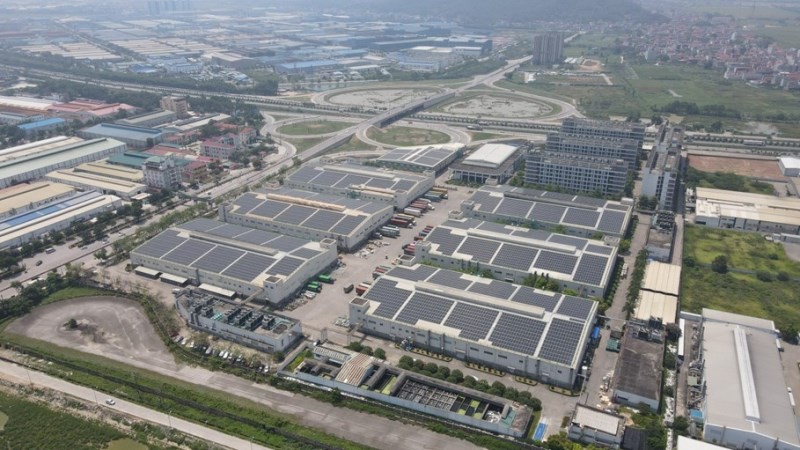
Against the increasing demand for rooftop solar installations in the FDI manufacturing sector in Vietnam, led by the electronics/semiconductor and textile sectors, Vietnam is considered an attractive market for foreign investors in developing distributed solar energy.
Developing renewable energy to tackle electricity shortages
Vietnam's electricity industry has experienced significant growth over the past few decades. The capacity of the power system and the demand for commercial electricity have steadily increased, with an average annual growth rate of 10.5% for commercial electricity between 2011 and 2020. Electricity output increased from 93 billion kWh in 2011 to 215 billion kWh in 2020.
Though the electricity growth rate in 2021 adjusted to a moderate growth rate of 3.4%, the figure is again projected at a 10% annual growth rate in the period of 2021 and 2030 to fuel the rapid urbanisation and manufacturing based economic growth model of Vietnam.
Thus, power shortages have been flagged to policy makers, despite the fact that rapid penetration of new production capacity from utility scale renewable sources in the last couple of years has been ramping up capacity by 25% but the majority of renewable production capacity is located in central and south Vietnam while the urbanisation of urban centres and major industrial clusters is in the north.
A worth noting fact is that production from hydro power is on decline as Vietnam is among most suffered country from climate change and El Nino is making the situation worse during this and the coming dry seasons, meanwhile the government of Vietnam is solid in keeping its commitments not to expand coal fired power production, given that the current power source structure heavily relies on fossil fuels, particularly coal-fired power, which accounts for approximately 45% of total power output.
In that context, the long-waited Master Plan of Power Development Number 8 (MPPD 8) was approved on May 15, after many delays, but still needs more solutions to boost both production and transmission capacity nationwide, especially in the north.
The plan places increased emphasis on renewable energy development compared to its predecessor. The goal is to achieve a renewable energy (not including hydropower) share of 31-39% in the overall energy mix by 2030, which translates to a capacity of 5,000-10,000 MW.
Additionally, through the Joint Equitable Energy Transition Partnership with Vietnam (JETP), the country has the potential to raise this percentage to 47%. Looking ahead to 2050, renewable energy is projected to comprise 67.5-71.5% of the entire energy system.
Aligned with the focus on renewable energy, Vietnam has set ambitious targets for the adoption of rooftop solar power. By 2050, the objective is for 80% factories of and 20% of residential houses and office buildings to utilise rooftop solar power for on-site consumption instead of feeding excess electricity back into the grid.
A golden era for the distributed solar energy sector?
According to experts and representatives of the business community in the field of renewable energy, Vietnam is an attractive market for investors in rooftop solar energy.
Chung Dieu Tuan, CEO of Copper Mountain Energy Solar - a local developer backed by Oman Investment Authorities, is upbeat about market prospects and stated that a key market driver is the ever-surging demand for rooftop solar installations among FDI manufacturing sectors in Vietnam led by the electronics/semiconductors sector, garment and textile sector.
As part of the global efforts of leading brands and corporations committing to be net zero, brands and the OEM manufacturers in Vietnam need to meet the deadlines of energy transformation to renewable sources.
By June 2023, total production capacity of rooftop solar/agrivoltaics systems has reached approximately 8 GWp from 1 GWh in December 2020 (VEPG Fact Sheet).
Total industrial and commercial roof area is approx. 80,000 ha (Savills report 2022) and the growth rate is estimated at 10%, while total area of rooftop utilised for solar energy production only accounts for 8%.
Hence the growth rate for rooftop solar energy development in Vietnam is believed to be among the fastest growing segments among newly installed capacity for coming 10 years.
One typical example, Foxconn - a leading manufacturer for Apple and other global brands with production facilities located in China and Vietnam, has recently successfully commissioned 19 MWp rooftop solar capacities in Vietnam’s Bac Giang province in June 2023, and will commission the next batch of rooftop solar system this July totalling 32 MWp, accounting for only 20% of Foxconn’s current roof areas in Vietnam.
This firm has seen aggressive expansion in Vietnam given the favourable social-political-economic fundamentals, and has placed rooftop solar as a significant part of their energy transformation in their current and future plants in the country as their first project was implemented well within only 3 months for licensing, procurement, installation and COD and supervised by global technical consultant.
Other electronics giants and global OEM producers like Samsung and LG are following Foxconn’s path and about to reveal their energy transformation in Vietnam within 2023. Other OEM manufacturers for Adidas, Nike and other textile, garment, fashion and shoes brands have also recently moved aggressively toward distributed solar energy under the same drivers.
However, the corporates and brands will have to look to the government of Vietnam to fully realise their ambitious energy transformation plan as the rooftop solar system can only provide around 20-30% of their actually energy consumption demand.
The FDI community has been in dialogue with the government of Vietnam to push for a Direct Power Purchase Agreement (DPPA).
In addition, the Government also needs to focus on developing a more urgent response programme to minimise the damage caused by power shortages and outages, and ensure long-term solutions for the possibility of periodic power shortages to address the issue of stabilising power supplies, in order to maintain business performance and overall economic resilience.
Source: NDO
Keywords: Vietnam, solar energy developers



















